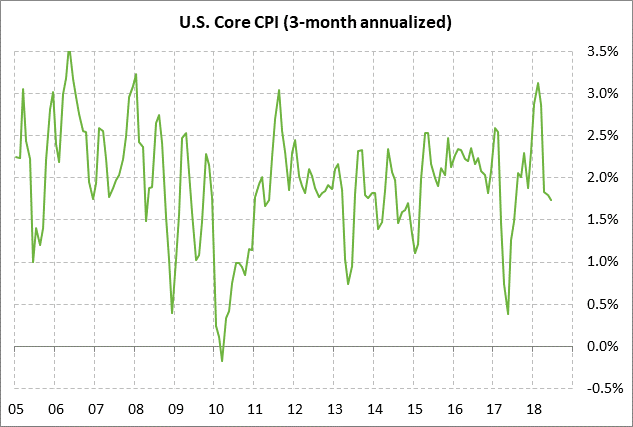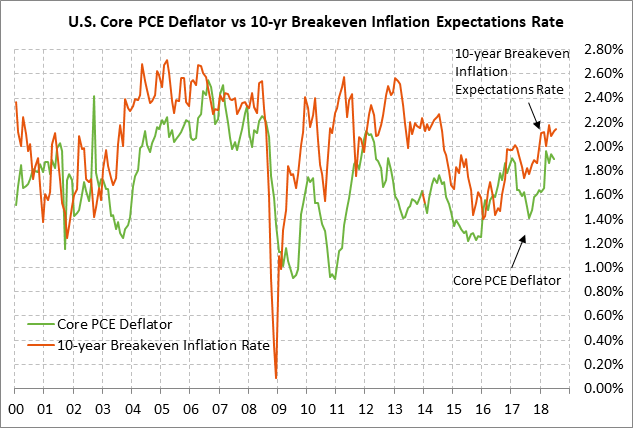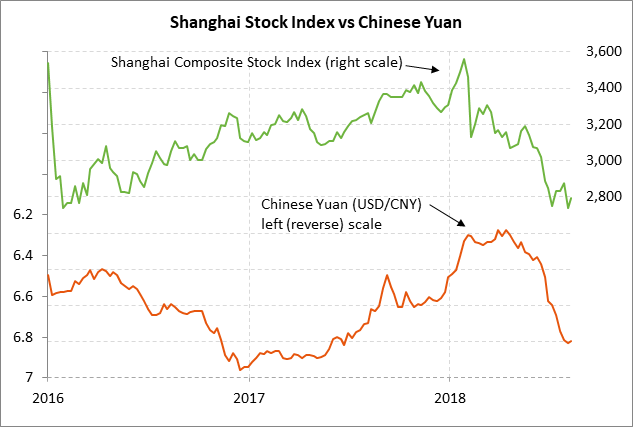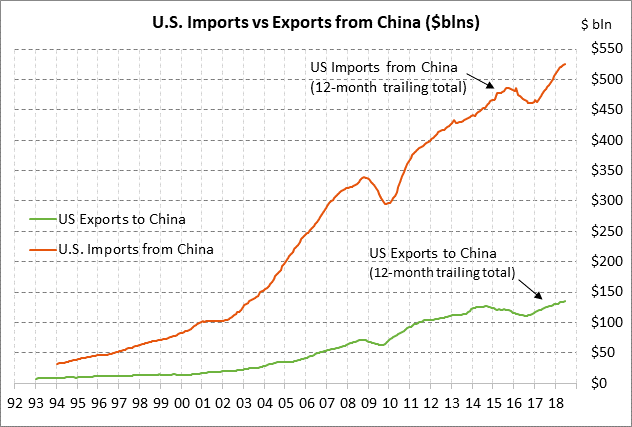- CPI expected to remain at a 6-1/2 year high
- Chinese markets stabilize but downside risks remain
CPI expected to remain at a 6-1/2 year high — The market consensus is for today’s July CPI report to be unchanged from June’s 6-1/2 year high of +2.9% y/y and for the July core CPI to be unchanged from June’s 10-year high of +2.3% y/y.
While the year-on-year figures are strong, the CPI on a 3-month annualized basis has been better behaved with a +2.3% increase in the CPI and a +1.7% increase in the core CPI. Moreover, the PCE deflator, which is the Fed’s preferred inflation measure, is also substantially below the year-on-year CPI figures. The PCE deflator in May and June rose to a 6-1/4 year high of +2.2% y/y and June’s core deflator of +1.9% was 0.1 point below March’s 6-1/4 year high of +2.0% y/y.
The good news is that inflation expectations have recently been stable and are not indicating any fresh inflation concerns that would cause renewed weakness in T-note prices. The 10-year breakeven inflation expectations rate reached a 3-3/4 year high of +2.21% in May, but in the past two months has been moving sideways near 2.12%, which is just modestly above the Fed’s +2.0% inflation target.
Yesterday’s PPI report was a bit weaker than expected, which cooled inflation concerns a bit. The July final-demand PPI eased to +3.3% from June’s 6-3/4 year high of +3.4% and the core PPI eased to +2.7% from June’s 6-3/4 year high of +2.7% y/y.
The U.S. inflation statistics have risen fairly sharply over the past year and are now at or above the Fed’s +2.0% inflation target. The Fed is not panicking about inflation since the Fed says that its inflation target is symmetrical and that a temporary period of above-target growth would be acceptable. Nevertheless, if the inflation statistics continue to move higher, then the Fed will be under pressure to speed up its rate-hike regime and raise rates higher than currently anticipated.
There are various potential events that could push inflation higher in coming months including (1) the strong economy, (2) an upside breakout in wage growth due to the very tight labor market, (3) an upward squeeze on oil prices caused by U.S. sanctions on Iran, and (4) higher prices from the tariffs and the indirect tariff effect of higher raw material and component prices.
A worrisome underlying factor is that the Fed has $3.4 trillion worth of excess high-powered money in the financial system, which could begin to fuel an inflation surge if the Fed isn’t cautious. The Fed is slowly drawing down its balance sheet, but it will be at least five years before the Fed gets its balance sheet down to a neutral level. That means that there is plenty of highly-flammable monetary fuel if inflation pressures should start to break out to the upside.
Chinese markets stabilize but downside risks remain — The Chinese markets this week have stabilized, leading to hopes that the worst is over for now. The Chinese yuan is consolidating modestly above last Friday’s 1-1/4 year low. The yuan has found some support after the Chinese government last Friday raised the margin on yuan forwards, making it more expensive for speculators to short the yuan.
Meanwhile, the Shanghai Composite index on Thursday rallied sharply by 1.83% to a new 1-week high. The index has now recovered by a total of +4.1% from the July’s 2-1/2 year low. The Chinese stock market has been encouraged by the halt in the yuan’s decline and by the government’s shift to stimulative policies to offset trade tensions.
While the losses in the yuan and Chinese stocks have been staunched for now, there are still substantial downside risks. There are only about four weeks left for talks until September 6, which is when the public comment period ends and the Trump administration will be free to implement its threat of a 25% tariff on $200 billion of Chinese products.
If that tariff goes through, then the U.S. will have tariffs on $250 billion of Chinese products, or nearly one-half of the $535 billion worth of China’s exports to the U.S. seen over the last 12 months. Those tariffs could put a dent in Chinese GDP of 0.3-0.4 points. More importantly, those tariffs could further undercut Chinese business and consumer confidence and hurt China’s financial markets, causing a snowballing effect. China is already battling a myriad of problems, the most important of which is massive debt levels, and China clearly does not need to add tariffs on half its exports to the U.S. to the mix.
Moreover, if China doesn’t come to the bargaining table after U.S. tariffs are imposed on $250 billion worth of Chinese goods, then President Trump has already said he will raise the total to $500 billion, which covers nearly all of China’s exports to the U.S. Tariffs on that scale could dent China’s GDP by 0.7-0.9 points or more.
The good news is that President Trump seems willing to back off tariffs if he thinks the trading partner is willing to make significant concessions in negotiations. Indeed, the EU recently managed to talk Mr. Trump into negotiations and a tariff cease-fire with only some vague promises to buy more U.S. goods such as soybeans and LNG. The problem, however, is that the U.S. is driving a much harder bargain with China with demands for fundamental changes in its economic development model, more respect for intellectual property rights, and a big cut in the US/Chinese trade deficit. Yet China has been unwilling to bargain away such key goals as its Made in China 2025 program, which is designed to help China climb the technological ladder to producing more advanced products. The trade road with China continues to be fraught with difficulties for the markets.





